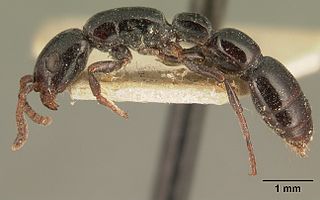
The Formicinae are a subfamily within the Formicidae containing ants of moderate evolutionary development.

Dorylinae is an ant subfamily, with distributions in both the Old World and New World. Brady et al. (2014) synonymized the previous dorylomorph subfamilies under Dorylinae., while Borowiec (2016) reviewed and revised the genera, resurrecting many genera which had previously been merged. Dorylinae genera are suggested to have evolved sometime between 102 to 74 million years ago, subsequently undergoing rapid adaptive radiation events during their early history.

Ponerinae is a subfamily of ants in the Poneromorph subfamilies group, with about 1,600 species in 47 extant genera, including Dinoponera gigantea - one of the world's largest species of ant. Mated workers have replaced the queen as the functional egg-layers in several species of ponerine ants. In such queenless species, the reproductive status of workers can only be determined through ovarian dissections.

Adetomyrma is a genus of ants endemic to Madagascar. Workers of this genus are blind. The type species Adetomyrma venatrix was described in 1994, with the genus being an atypical member of its tribe, the Amblyoponini. This tribe includes the Dracula ants, members of which can feed on the hemolymph of larvae and pupae.

Myrmicinae is a subfamily of ants, with about 140 extant genera; their distribution is cosmopolitan. The pupae lack cocoons. Some species retain a functional sting. The petioles of Myrmicinae consist of two nodes. The nests are permanent and in soil, rotting wood, under stones, or in trees.

Dolichoderinae is a subfamily of ants, which includes species such as the Argentine ant, the erratic ant, the odorous house ant, and the cone ant. The subfamily presents a great diversity of species throughout the world, distributed in different biogeographic realms, from the Palearctic, Nearctic, Afrotropical region and Malaysia, to the Middle East, Australian, and Neotropical regions.

Amblyopone is a genus of 10 species of ants, found in Australia, New Caledonia, New Guinea and New Zealand. Ants of this genus possess the gamergate, meaning workers are able to reproduce within a colony lacking a queen.

Proceratiinae is a subfamily of ants in the poneromorph subfamilies group, with three extant genera, of which most are tropical or subtropical, although overall distribution is worldwide.

Stigmatomma is a genus of ants in the subfamily Amblyoponinae. The genus has a worldwide distribution, and like most other amblyoponines, Stigmatomma species are specialized predators. First described by Roger (1859), it was for a long time considered to be a synonym of Amblyopone until it was revived as an independent genus by Yoshimura & Fisher (2012) based on worker mandible morphology.

Mystrium is a rare genus of ants in the subfamily Amblyoponinae. First described by Roger (1862) with the description of the queen of M. mysticum, the genus contains 14 species, all of which occur in the rainforests of the Old World with over half of the species endemic to the Malagasy region.

Leptanilloides is a genus of ants in the subfamily Dorylinae. Leptanilloides is an uncommonly collected genus with subterranean habits in the New World Andean and sub-Andean tropics.

Vicinopone is a monotypic Afrotropical genus of arboreal ants in the subfamily Dorylinae. Vicinopone conciliatrix, the only species in the genus, was first described as Simopone conciliatrix by Brown in 1975 and was transferred to its own genus by Bolton & Fisher in 2012. V. conciliatrix appears to be quite widely distributed but rare. Its rarity is more likely apparent than real because it nests and forages in trees, rarely if ever coming down to the ground.

Simopone is a genus of predominantly arboreal ants in the subfamily Dorylinae. The genus is widely distributed in the Old World tropics, with the majority of species in Madagascar and sub-Saharan Africa.

Stigmatomma mulanae is a species of ant of the genus Stigmatomma. Described by Xu in 2000 from a single dealate queen found in 1998 in the Xishuangbanna Nature Reserve in Yunnan Province, it was placed as the type species of Bannapone, under the name Bannapone mulanae. It was moved to Stigmatomma by Ward & Fisher (2016).

Leptogenys is a genus of ants in the subfamily Ponerinae. Leptogenys is the most diverse ponerine ant genus in the world; it is widespread throughout tropical and subtropical regions and there are over 260 extant species described. Most species have ergatoid queens, and many have falcate, bowed mandibles and are specialists on isopod prey.

Promyopias is an Afrotropical genus of ant in the subfamily Ponerinae containing the single species Promyopias silvestrii. The rare genus has previously been regarded as a separate genus, as a subgenus and as a provisional synonymy, but was reinstated at genus-rank in 2008.

Phrynoponera is a strictly Afrotropical genus of ants in the subfamily Ponerinae.
Stigmatomma scrobiceps is a species of ant in the genus Stigmatomma. It was described as Bannapone scrobiceps by Guénard et al. in 2013, based on two specimens collected in Yunnan Province, China, and placed as the second species in Bannapone. It was moved to Stigmatomma by Ward & Fisher (2016).
















